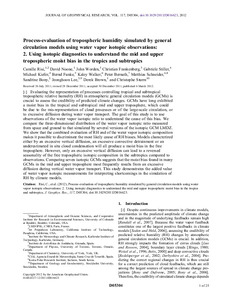Por favor, use este identificador para citar o enlazar este ítem:
http://hdl.handle.net/20.500.11765/2393
Process-evaluation of tropospheric humidity simulated by general circulation models using water vapor isotopic observations: 2. Using isotopic diagnostics to understand the mid and upper tropospheric moist bias in the tropics and subtropics
| Título : | Process-evaluation of tropospheric humidity simulated by general circulation models using water vapor isotopic observations: 2. Using isotopic diagnostics to understand the mid and upper tropospheric moist bias in the tropics and subtropics |
| Autor : | Risi, Camille; Noone, David; Worden, John; Frankenberg, Christian; Stiller, Gabriele P.; Kiefer, Michael; Funke, Bernd; Walker, Kaley; Bernath, Peter; Schneider, Matthias
 ; Bony, Sandrine; Lee, Jeonghoon; Brown, Derek; Sturm, Christophe
; Bony, Sandrine; Lee, Jeonghoon; Brown, Derek; Sturm, Christophe |
| Palabras clave : | General circulation models; Process-based evaluation; Relative humidity; Isotopes |
| Fecha de publicación : | 2012 |
| Editor: | American Geophysical Union |
| Citación : | Journal of Geophysical Research: Atmospheres. 2012, 117(D5), p. D05304 |
| Versión del editor: | https://dx.doi.org/10.1029/2011JD016623 |
| Resumen : | Evaluating the representation of processes controlling tropical and subtropical tropospheric relative humidity (RH) in atmospheric general circulation models (GCMs) is crucial to assess the credibility of predicted climate changes. GCMs have long exhibited a moist bias in the tropical and subtropical mid and upper troposphere, which could be due to the mis-representation of cloud processes or of the large-scale circulation, or to excessive diffusion during water vapor transport. The goal of this study is to use observations of the water vapor isotopic ratio to understand the cause of this bias. We compare the three-dimensional distribution of the water vapor isotopic ratio measured from space and ground to that simulated by several versions of the isotopic GCM LMDZ. We show that the combined evaluation of RH and of the water vapor isotopic composition makes it possible to discriminate the most likely cause of RH biases. Models characterized either by an excessive vertical diffusion, an excessive convective detrainment or an underestimated in situ cloud condensation will all produce a moist bias in the free troposphere. However, only an excessive vertical diffusion can lead to a reversed seasonality of the free tropospheric isotopic composition in the subtropics compared to observations. Comparing seven isotopic GCMs suggests that the moist bias found in many GCMs in the mid and upper troposphere most frequently results from an excessive diffusion during vertical water vapor transport. This study demonstrates the added value of water vapor isotopic measurements for interpreting shortcomings in the simulation of RH by climate models. |
| Patrocinador: | The mid-infrared FTIR retrievals have been performed in the framework of the project MUSICA (http://www.imk-asf.kit.edu/english/ musica), which is funded by the European Research Council under the European Community’s Seventh Framework Programme (FP7/2007– 2013)/ERC grant agreement 256961. This work was supported by NASA Energy and Water-cycle Study (07-NEWS07-0020) and NASA Atmospheric Composition program (NNX08AR23G). |
| URI : | http://hdl.handle.net/20.500.11765/2393 |
| ISSN : | 2169-897X 2169-8996 |
| Colecciones: | Artículos científicos 2010-2014 |
Ficheros en este ítem:
| Fichero | Descripción | Tamaño | Formato | ||
|---|---|---|---|---|---|
| Risi_2012-JGRSE(2).pdf | 1,57 MB | Adobe PDF |  Visualizar/Abrir |
Los ítems de Arcimis están protegidos por una Licencia Creative Commons, salvo que se indique lo contrario.





